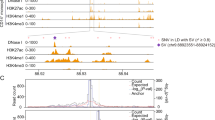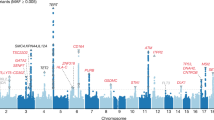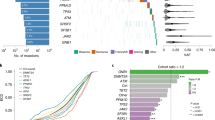Abstract
Hematological traits are important clinical parameters. To test the effects of rare and low-frequency coding variants on hematological traits, we analyzed hemoglobin concentration, hematocrit levels, white blood cell (WBC) counts and platelet counts in 31,340 individuals genotyped on an exome array. We identified several missense variants in CXCR2 associated with reduced WBC count (gene-based P = 2.6 × 10−13). In a separate family-based resequencing study, we identified a CXCR2 frameshift mutation in a pedigree with congenital neutropenia that abolished ligand-induced CXCR2 signal transduction and chemotaxis. We also identified missense or splice-site variants in key hematopoiesis regulators (EPO, TFR2, HBB, TUBB1 and SH2B3) associated with blood cell traits. Finally, we were able to detect associations between a rare somatic JAK2 mutation (encoding p.Val617Phe) and platelet count (P = 3.9 × 10−22) as well as hemoglobin concentration (P = 0.002), hematocrit levels (P = 9.5 × 10−7) and WBC count (P = 3.1 × 10−5). In conclusion, exome arrays complement genome-wide association studies in identifying new variants that contribute to complex human traits.
This is a preview of subscription content, access via your institution
Access options
Subscribe to this journal
Receive 12 print issues and online access
$209.00 per year
only $17.42 per issue
Buy this article
- Purchase on Springer Link
- Instant access to full article PDF
Prices may be subject to local taxes which are calculated during checkout



Similar content being viewed by others
References
Nalls, M.A. et al. Multiple loci are associated with white blood cell phenotypes. PLoS Genet. 7, e1002113 (2011).
Gieger, C. et al. New gene functions in megakaryopoiesis and platelet formation. Nature 480, 201–208 (2011).
van der Harst, P. et al. Seventy-five genetic loci influencing the human red blood cell. Nature 492, 369–375 (2012).
Zhou, Z. et al. USF and NF-E2 cooperate to regulate the recruitment and activity of RNA polymerase II in the β-globin gene locus. J. Biol. Chem. 285, 15894–15905 (2010).
de la Chapelle, A., Sistonen, P., Lehvaslaiho, H., Ikkala, E. & Juvonen, E. Familial erythrocytosis genetically linked to erythropoietin receptor gene. Lancet 341, 82–84 (1993).
Biasiotto, G. et al. New TFR2 mutations in young Italian patients with hemochromatosis. Haematologica 93, 309–310 (2008).
Pelucchi, S. et al. Expression of hepcidin and other iron-related genes in type 3 hemochromatosis due to a novel mutation in transferrin receptor-2. Haematologica 94, 276–279 (2009).
Qayyum, R. et al. A meta-analysis and genome-wide association study of platelet count and mean platelet volume in African Americans. PLoS Genet. 8, e1002491 (2012).
Forand, A. et al. EKLF-driven PIT1 expression is critical for mouse erythroid maturation in vivo and in vitro. Blood 121, 666–678 (2013).
Baxter, E.J. et al. Acquired mutation of the tyrosine kinase JAK2 in human myeloproliferative disorders. Lancet 365, 1054–1061 (2005).
James, C. et al. A unique clonal JAK2 mutation leading to constitutive signalling causes polycythaemia vera. Nature 434, 1144–1148 (2005).
Kralovics, R. et al. A gain-of-function mutation of JAK2 in myeloproliferative disorders. N. Engl. J. Med. 352, 1779–1790 (2005).
Levine, R.L. et al. Activating mutation in the tyrosine kinase JAK2 in polycythemia vera, essential thrombocythemia, and myeloid metaplasia with myelofibrosis. Cancer Cell 7, 387–397 (2005).
Bohinjec, J. Myelokathexis: chronic neutropenia with hyperplastic bone marrow and hypersegmented neutrophils in two siblings. Blut 42, 191–196 (1981).
Xu, X. et al. JAK2V617F: prevalence in a large Chinese hospital population. Blood 109, 339–342 (2007).
Sidon, P., El Housni, H., Dessars, B. & Heimann, P. The JAK2V617F mutation is detectable at very low level in peripheral blood of healthy donors. Leukemia 20, 1622 (2006).
Vannucchi, A.M., Pieri, L. & Guglielmelli, P. JAK2 allele burden in the myeloproliferative neoplasms: effects on phenotype, prognosis and change with treatment. Ther. Adv. Hematol. 2, 21–32 (2011).
Oh, S.T. When the brakes are lost: LNK dysfunction in mice, men, and myeloproliferative neoplasms. Ther. Adv. Hematol. 2, 11–19 (2011).
Bersenev, A., Wu, C., Balcerek, J. & Tong, W. Lnk controls mouse hematopoietic stem cell self-renewal and quiescence through direct interactions with JAK2. J. Clin. Invest. 118, 2832–2844 (2008).
Beck, L. et al. The phosphate transporter PiT1 (Slc20a1) revealed as a new essential gene for mouse liver development. PLoS ONE 5, e9148 (2010).
Gerstein, M.B. et al. Architecture of the human regulatory network derived from ENCODE data. Nature 489, 91–100 (2012).
McMullin, M.F., Wu, C., Percy, M.J. & Tong, W. A nonsynonymous LNK polymorphism associated with idiopathic erythrocytosis. Am. J. Hematol. 86, 962–964 (2011).
Macari, E.R. & Lowrey, C.H. Induction of human fetal hemoglobin via the NRF2 antioxidant response signaling pathway. Blood 117, 5987–5997 (2011).
Zeller, T. et al. Genetics and beyond—the transcriptome of human monocytes and disease susceptibility. PLoS ONE 5, e10693 (2010).
Stranger, B.E. et al. Population genomics of human gene expression. Nat. Genet. 39, 1217–1224 (2007).
Barrett, J.C. et al. Genome-wide association study and meta-analysis find that over 40 loci affect risk of type 1 diabetes. Nat. Genet. 41, 703–707 (2009).
Sawcer, S. et al. Genetic risk and a primary role for cell-mediated immune mechanisms in multiple sclerosis. Nature 476, 214–219 (2011).
Jostins, L. et al. Host-microbe interactions have shaped the genetic architecture of inflammatory bowel disease. Nature 491, 119–124 (2012).
Stasi, R. Immune thrombocytopenia: pathophysiologic and clinical update. Semin. Thromb. Hemost. 38, 454–462 (2012).
Johnston, C.M. et al. Large-scale population study of human cell lines indicates that dosage compensation is virtually complete. PLoS Genet. 4, e9 (2008).
Cernelc, P. et al. Effects of molgramostim, filgrastim and lenograstim in the treatment of myelokathexis. Pflugers Arch. 440, R81–R82 (2000).
Park, S.H. et al. Structure of the chemokine receptor CXCR1 in phospholipid bilayers. Nature 491, 779–783 (2012).
Salchow, K. et al. A common intracellular allosteric binding site for antagonists of the CXCR2 receptor. Br. J. Pharmacol. 159, 1429–1439 (2010).
Marioni, J.C. et al. Breaking the waves: improved detection of copy number variation from microarray-based comparative genomic hybridization. Genome Biol. 8, R228 (2007).
Sabeti, P.C. et al. Genome-wide detection and characterization of positive selection in human populations. Nature 449, 913–918 (2007).
Bird, C.P. et al. Fast-evolving noncoding sequences in the human genome. Genome Biol. 8, R118 (2007).
ENCODE Project Consortium. Identification and analysis of functional elements in 1% of the human genome by the ENCODE pilot project. Nature 447, 799–816 (2007).
Hernandez, P.A. et al. Mutations in the chemokine receptor gene CXCR4 are associated with WHIM syndrome, a combined immunodeficiency disease. Nat. Genet. 34, 70–74 (2003).
Beaudoin, M. et al. Pooled DNA resequencing of 68 myocardial infarction candidate genes in French Canadians. Circ. Cardiovasc. Genet. 5, 547–554 (2012).
Women's Health Initiative Study Group. Design of the Women's Health Initiative clinical trial and observational study. Control. Clin. Trials 19, 61–109 (1998).
Völzke, H. et al. Cohort profile: the study of health in Pomerania. Int. J. Epidemiol. 40, 294–307 (2011).
Goldstein, J.I. et al. zCall: a rare variant caller for array-based genotyping: genetics and population analysis. Bioinformatics 28, 2543–2545 (2012).
Purcell, S. et al. PLINK: a tool set for whole-genome association and population-based linkage analyses. Am. J. Hum. Genet. 81, 559–575 (2007).
1000 Genomes Project Consortium. An integrated map of genetic variation from 1,092 human genomes. Nature 491, 56–65 (2012).
Price, A.L. et al. Principal components analysis corrects for stratification in genome-wide association studies. Nat. Genet. 38, 904–909 (2006).
Yang, J., Lee, S.H., Goddard, M.E. & Visscher, P.M. GCTA: a tool for genome-wide complex trait analysis. Am. J. Hum. Genet. 88, 76–82 (2011).
R Core Team. R: A Language and Environment for Statistical Computing (R Foundation for Statistical Computing, Vienna, 2013).
Liu, D.J. et al. Meta-analysis of gene-level tests for rare variant association. Nat. Genet. 46, 200–204 (2014).
Willer, C.J., Li, Y. & Abecasis, G.R. METAL: fast and efficient meta-analysis of genomewide association scans. Bioinformatics 26, 2190–2191 (2010).
Kent, W.J. et al. The human genome browser at UCSC. Genome Res. 12, 996–1006 (2002).
Rozen, S. & Skaletsky, H. Primer3 on the WWW for general users and for biologist programmers. Methods Mol. Biol. 132, 365–386 (2000).
Acknowledgements
We thank all participants and staff of the MHI Biobank and acknowledge the technical support of the Beaulieu-Saucier MHI Pharmacogenomic Center. This work was supported by the Centre of Excellence in Personalized Medicine (CEPMed), Fonds de Recherche du Québec–Santé (FRQS), the Canada Research Chair program and the MHI Foundation. The WHI program is funded by the National Heart, Lung, and Blood Institute, the US National Institutes of Health and the US Department of Health and Human Services (HHSN268201100046C, HHSN268201100001C, HHSN268201100002C, HHSN268201100003C, HHSN268201100004C and HHSN271201100004C). Exome chip data and analysis were supported through the Exome Sequencing Project (NHLBI RC2 HL-102924, RC2 HL-102925 and RC2 HL-102926), the Genetics and Epidemiology of Colorectal Cancer Consortium (NCI CA137088), the Genomics and Randomized Trials Network (NHGRI U01-HG005152) and a National Cancer Institute training grant (R25CA094880). The authors thank the WHI investigators and staff for their dedication and the study participants for making the program possible. SHIP is part of the Community Medicine Research network of the University of Greifswald, Germany, which is funded by the Federal Ministry of Education and Research (grants 01ZZ9603, 01ZZ0103 and 01ZZ0403), the Ministry of Cultural Affairs, as well as the Social Ministry of the Federal State of Mecklenburg–West Pomerania, and the network Greifswald Approach to Individualized Medicine (GANI_MED) funded by the Federal Ministry of Education and Research (grant 03IS2061A). Generation of ExomeChip data has been supported by the Federal Ministry of Education and Research (grant 03Z1CN22) and the Federal State of Mecklenburg–West Pomerania. The University of Greifswald is a member of the Center of Knowledge Interchange program of Siemens AG and the Caché Campus program of InterSystems. G.A.D. acknowledges support from US National Institutes of Health award P01AI061093.
Author information
Authors and Affiliations
Contributions
P.L.A., G.A.D., A.P.R. and G.L. conceived and designed the experiments. P.L.A., A.T., U.S., A.O., K.S.L., G.A.D., A.P.R. and G.L. performed the experiments. P.L.A., A.T., U.S., A.O., K.S.L., G.A.D., A.P.R. and G.L. analyzed the data. All authors contributed reagents and materials. P.L.A., G.A.D., A.P.R. and G.L. wrote the manuscript with contributions from all authors.
Corresponding authors
Ethics declarations
Competing interests
The authors declare no competing financial interests.
Integrated supplementary information
Supplementary Figure 1 Quantile-quantile plots of single-variant association results.
(a) Hematocrit. (b) Hemoglobin. (c) White blood cell count. (d) Platelet count.
Supplementary Figure 2 Quantile-quantile plots of gene-based burden T1 results.
(a) Hematocrit. (b) Hemoglobin. (c) White blood cell count. (d) Platelet count. For each gene, we only considered missense, nonsense and splice-site variants with a minor allele frequency of <1%.
Supplementary Figure 3 Quantile-quantile plots of gene-based SKAT results.
(a) Hematocrit. (b) Hemoglobin. (c) White blood cell count. (d) Platelet count. For each gene, we only considered missense, nonsense and splice-site variants with a minor allele frequency of <5%.
Supplementary Figure 4 Impact of the mutation p.Asp70Asn in EPO.
(a) Crystal structure of erythropoietin (EPO, yellow) with two erythropoietin receptor subunits (EPOR, green and red)24. The white circle indicates the interface between EPO and EPOR magnified in (b) and (c). In (b) and (c), the white circles highlight residue 70 (43 after cleavage of the propeptide). Replacing Asp70 (b) by Asn70 (c) may destabilize the EPO loop that interacts with EPOR because it disrupts a hydrogen bond between Asp70 and Thr71.
Supplementary Figure 5 Intensity plots for JAK2 p.Val617Phe in the Montreal Heart Institute (MHI; left) and the Study of Health in Pomerania (SHIP; right) genotyped on the Illumina HumanExome BeadChip.
Density plots for the Women's Health Initiative were not available.
Supplementary Figure 6 Mutations in SH2B3 may interfere with JAK2 binding.
Crystal structure of the SH2-B SH2 domain (beige) with JAK2 phosphotyrosine peptide (pTyr813, yellow)25. JAK2 pTyr813 interacts with arginine residues in the SH2-B BC loop. The glutamate residues identified in our association study (Glu395 and Glu400, green) correspond to Glu558 and Glu563 in the SH2-B sequence. They are directly in the BC loop that interacts with JAK2. Glu563 interacts with Arg578.
Supplementary Figure 7 UCSC ENCODE tracks for the rs1465788 variant near ZFP36L1.
The rs1465788 variant appears to be in a K562 FAIRE nucleosome depletion peak. rs1465788 is also in high LD with rs2236263 (r2 = 0.91 in CEU), rs3742887 (r2 = 0.99 in CEU) and rs6573857 (r2 = 1 in CEU), which all lie in an active promoter for ZFP36L1.
Supplementary Figure 8 Crystal structure of CXCR1 in a phospholipid bilayer.
CXCR2, like CXCR1 and CXCR4, is a protein with seven transmembrane (TM) domains. In purple are the CXCR1 residues that correspond to the missense mutations identified in CXCR2 (two CXCR2 residues, Met6 and Ala37, do not have their CXCR1 equivalent on this structure). In parentheses are the corresponding CXCR2 residues. CXCR2 Arg289 and Arg294 are in TM domains. The remaining four CXCR2 residues (Arg144, Arg236, Arg248, His332) are in intracellular loops.
Supplementary Figure 9 Analysis of CXCR2 in a myelokathexis pedigree.
(a) A myelokathexis pedigree with two affected (filled) and two unaffected (open) daughters is shown at left. The CXCR2 sequence trace shows a single-base deletion corresponding to coding sequence position 968 in individual I-2 (unaffected) compared to an unrelated control (arrow). (b) An NcoI recognition site (CCATGG) that gives a 325-bp fragment when a wild-type amplicon is digested is destroyed by the c.968delA mutation so that the 375-bp undigested amplicon persists. Affected siblings II-2 and II-4 are homozygous for the deletion mutation, parents and sibling II-1 are heterozygous for the mutation, and sibling II-3 is homozygous for the wild-type allele. White blood cell (WBC) counts for each family member are shown below. (c) A structural model of CXCR2 with the conserved GPCR motifs (purple, intracellular loop 2; dark blue, DRY; green, NPXXY), the mutant frameshift peptide (orange) and the truncated wild-type tail (red) indicated. The frameshift is located in helix 8, which is predicted to be parallel to the plasma membrane. Amino acid sequences from the wild-type and mutant CXCR2 constructs are shown. The CXCR2fs construct contains a six-amino-acid frameshift peptide (LDSSRF). Amino acid colors correspond to those used in the structure model. The black bar over the primary sequence indicates the location of a highly conserved LLKIL dileucine motif that is critical for receptor-mediated chemotaxis27.
Supplementary information
Supplementary Text and Figures
Supplementary Figures 1–9, Supplementary Tables 1–7 and Supplementary Note (PDF 2538 kb)
Rights and permissions
About this article
Cite this article
Auer, P., Teumer, A., Schick, U. et al. Rare and low-frequency coding variants in CXCR2 and other genes are associated with hematological traits. Nat Genet 46, 629–634 (2014). https://doi.org/10.1038/ng.2962
Received:
Accepted:
Published:
Issue Date:
DOI: https://doi.org/10.1038/ng.2962
This article is cited by
-
Systematic assessment of chemokine ligand bias at the human chemokine receptor CXCR2 indicates G protein bias over β-arrestin recruitment and receptor internalization
Cell Communication and Signaling (2024)
-
Robust association tests for quantitative traits on the X chromosome
Heredity (2022)
-
Heterogeneous genetic landscape of congenital neutropenia in Korean patients revealed by whole exome sequencing: genetic, phenotypic and histologic correlations
Scientific Reports (2022)
-
Fount, fate, features, and function of renal erythropoietin-producing cells
Pflügers Archiv - European Journal of Physiology (2022)
-
Disease Progression of WHIM Syndrome in an International Cohort of 66 Pediatric and Adult Patients
Journal of Clinical Immunology (2022)



